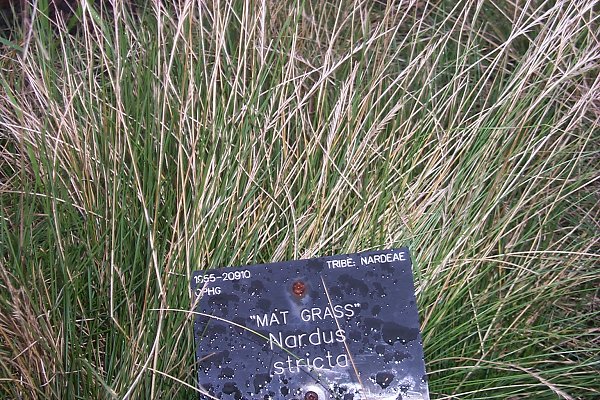Nardus stricta* L. Sp. Pl. 53 (1753).
Classification. (GPWG 2001) : Subfamily Pooideae. Tribe Nardeae.
Type of Basionym or Protologue Information: LT: Anon., Europe (LINN-73.5). LT designated by Cope in Jarvis et al., Regnum Veg. 127: 69 (1993).
Key references (books and floras): [2002] D.Sharp & B.K.Simon, AusGrass, Grasses of Australia, [2009] A.Wilson (ed.). Flora of Australia, Vol 44A. Poaceae 2 (11).
Illustrations: [2009]. A.Wilson (ed.), Flora of Australia 44A: Poaceae 2 (100, Fig.14).
Habit. Perennial. Rhizomes present, short. Culms erect, 10–40(–60) cm tall, wiry, 1 -noded. Leaves mostly basal. Leaf-sheaths smooth. Ligule an eciliate membrane, 1–2 mm long, membranous, truncate. Leaf-blades filiform, involute, 4–30 cm long, 0.5–1 mm wide.
Inflorescence. Inflorescence solid, a raceme. Racemes 1, linear, 3–8 cm long.
Spikelets. Spikelets sessile. Fertile spikelets 1-flowered, comprising 1 fertile floret(s), without rachilla extension, lanceolate, dorsally compressed, 5–9 mm long.
Glumes. Lower glume ovate.
Florets. Fertile lemma 5–9 mm long, keeled, 3 -nerved. Lemma apex awned, 1 -awned. Median (principal) awn 1–3 mm long overall. Palea 2 -nerved. Lodicules absent or vestigial. Anthers 3. Grain 3–4 mm long.
Continental Distribution: Europe, Africa, Temperate Asia, Australasia, North America, and South America.
Australian Distribution: Tasmania.
Tasmania: West Coast.
Notes. Introduced from Europe into Tasmania, where it is uncommon in swampy areas on flood plains of the King River near Gormaston and south of Queenstown.


